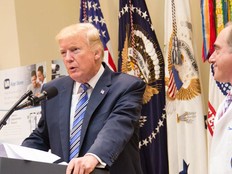How Mobile Technology Is Driving Language Translation
Around the globe, federal workers face a major challenge in overcoming language barriers. From service members deployed in strife-torn countries to diplomatic workers to medical personnel treating victims of a natural disaster, communication is critical to accomplishing the mission. Mobile technologies — along with better networks and communication tools — are playing a major role in helping agencies overcome these limitations.
“There is a tremendous interest in languages in every branch of government,” says Donald DePalma, chief strategy officer at Common Sense Advisory, a market research company focusing on language translation. “With mobile devices, the various agencies can equip all their employees with ready access to language interpretation.”
Smartphones and tablets are ubiquitous devices that can easily serve as platforms for translation programs. A growing number of agencies are equipping personnel with mobile devices and translation software that allow them to more efficiently complete their mission.
The Road to Mobility
With hundreds of embassies and consulates overseas, the State Department is a prime candidate for mobile translation. Although the department has yet to formalize its plan, Haar Sandhu, division chief of State’s Mobile Computing Office, says the department is serious about its commitment to expand its mobile capabilities with technologies such as language translation.
“State has many bureaus that will reap significant benefits from mobile translation technology,” he said. “For example, Consular Affairs has staff resources stationed across more than 270 offices worldwide, while the Bureau of Diplomatic Security and our Foreign Service Institute provide language training for the department and other government resources.”
Sandhu expects the State Department to continue work on its mobile policy and governance, including policy on which mobile devices the department will provide to employees. Once the policy is set, bureaus will be able to request mobile translation apps for approval.
“We see a lot of need. For example, posts often have to translate documents, and mobile translation products will provide a quick translation,” Sandhu says. “Or individuals at embassies could carry a mobile device where they can speak into it in English and it will translate into the language they need.”
Commercial, Custom or Somewhere in Between?
While many commercial mobile translation options are effective, they often cannot provide the capabilities or security levels that federal agencies require. Most text-based mobile machine translation solutions call out to unsecured servers in the cloud over unencrypted phone lines — a serious issue for translating sensitive data.
While several federal agencies have sought to develop custom translation systems, these efforts have generally been expensive. To address security concerns while limiting costs, several agencies are customizing commercially available applications. This provides the best of both worlds — a proven platform that can be customized to meet an agency’s needs.
A Brief History of Military Translation Technology
Early 2000s: The Defense Advanced Research Projects Agency develops the Phraselator, a rudimentary translation system used by forces in Iraq on handheld, one-way speech recognition devices.
2006: IBM supplies the U.S. Joint Forces Command with notebook computers loaded with its Multilingual Automatic Speech-to-Speech Translator (Mastor), a program that translates English to colloquial Arabic.
2006: DARPA spearheads the development of IraqComm, a mobile translation device that provides soldiers with basic two-way, speech-to-speech foreign language communication.
2008: The Army starts the Sequoyah program (now called the Machine Foreign Language Translation System) to develop and procure automated foreign language translation products for speech and text translation in a variety of languages and on a variety of platforms.
2011: DARPA initiates the Broad Operational Language Translation program to enable users to engage in complex conversations with Arabic or Mandarin Chinese speakers.
2012: Raytheon BBN is awarded a $5.5 million contract to develop speech and text translation for the Army for use on multiple devices.
That’s the route the Telemedicine and Advanced Technology Research Center (TATRC) at the U.S. Army Medical Research & Materiel Command has taken for its Medical Application of Speech Translation program.
With MAST, Cynthia Barrigan, the center’s program manager and global health engagement lead, sought an effective way for deployed medics working overseas to learn language and communicate with medical teams and patients who receive medical care as part of the military’s global health engagements.
TATRC has worked in support of the U.S. Southern Command on a speech-to-speech and speech-to-text English-Spanish translation capability that could be tuned for use in overseas medical settings.
“I had a long list of required features from the user community,” Barrigan says. “First, it had to work on mobile devices, because the organization’s medical personnel must be very mobile. And in addition to being cost-effective and easy to use, it had to be usable even without a connection to the Internet, since many of the places personnel went didn’t have access to telecommunication networks.”
At the time, the only product on the market that met the minimum set of requirements was an app called Jibbigo, developed by Alex Waibel, a professor at Carnegie Mellon University and founder of Pittsburgh-based Mobile Technologies.
The Next Step in Tackling Language Barriers
After curating and adding simulated medical speech and audio data into Jibbigo, Barrigan and her team from the Army Research, Development and Engineering Command’s Communications Electronics Research Development and Engineering Center conducted a limited field test during a training exercise in Honduras. During a three-day period, medical personnel, who previously used books of phrases to help communicate for these exercises, treated 1,500 patients with the help of the improved application, using both tablets and smartphones. Now that research has demonstrated that the technology works for the medical domain, the Southern Command must decide whether it wants to customize this specialized medical version of Jibbigo further and adopt the tools for long-term use, she says.
“We believe that a key step to building long-lasting relationships with our partners is to be able to communicate and share information, and that’s why SOUTHCOM places great importance on language and cultural awareness,” says Rear Adm. George W. Ballance, director of Theater Engagement for the Southern Command. “At the same time, we recognize the importance of advanced tools that enhance military agility such as mobile translation devices.”
Ballance says MAST would have been valuable during responses to disasters such as the 2010 earthquake in Haiti. “We had to rely heavily on translators, and even then they weren’t always available,” he adds. “For the future, I see mobile translation tools, particularly for specialized functions such as medical care, as a step forward in military capability and enabling more effective collaboration with our partners.”









